Mathematical Model of Relativistic Anisotropic Compact Stellar Model Admitting Linear Equation of State
2018-11-19SumitaBanerjee
Sumita Banerjee
Department of Mathematics,Budge Budge Institute of Technology,Kolkata-700137,India
AbstractIn present paper,a static,spherically symmetric,anisotropic stellar object has been discussed by assuming a linear relationship between the matter density ρ and radial pressure pr.The interior solution is continuously matched with the exterior Schwarzschild vacuum solution at the junction interface.Various physical features viz.energy conditions,mass-radius relationship,stability are analyzed for our stellar model.By assigning some particular value to the arbitrary constants we have obtained a model of compact star of radius 6.7 km.and mass 1.148 M⊙,which is very close to the observational data of the compact star Her X-1 proposed by Rawls et al.[Rawls,et al.,Astrophys.J.730(2011)25].We have obtained that the model satisfies all the regularity conditions.We have found that our proposed model is stable as well as singularity-free.
Key words:compact,anisotropic,spherically symmetric,singularity free
1 Introduction
In 1915 Einstein proposed General Theory of Relativity and the famous field equations.In the year 1916 Schwarzschild solved Einstein’s field equation for the interior of compact star in Hydrostatic equilibrium.After that have been investigated the relativistic astrophysical objects relating to static isotropic and anisotropic stellar type configuration in both theoretical and observational point of view.Exploration of astrophysical may provide an explanation to the queries about the fundamental laws of nature dealing with cosmic events and with the properties of matter under extreme conditions.
The study of compact object is always an interesting topic to the researchers.Theoretically there exist a number of comprehensive collections[1]of static,spherically symmetric solutions.These studies reveal that out of 127 published solutions only 16 of these satisfy all the physical conditions.According to Ruderman[2]it is found that the density of the core beyond the density∼1015gm/cc.provides the anisotropic nature of the stellar object i.e.,the pressure can be decomposed into two parts:radial pressure prand transverse pressure pt,where ptis in the orthogonal to pr.Anisotropy can be introduced by the existence of a solid stellar core or by the presence of a type 3A super fluid as indicated by Ref.[3],different kinds of phase transitions[4]or pion condensation.[5]According to Dev and Gleiser[6]it is revealed that pressure anisotropy affects the physical properties,stability and structure of stellar matter.The stability of stellar bodies is improved for positive measure of anisotropy when compared to configurations of isotropic stellar objects.[7]A natural question concerned to spherically symmetric relativistic static objects is to determine an upper bound on the compactness ratio m/r,where m is the ADM mass and r is the radius of the boundary of the static object.Reference[8]shows that a spherically symmetric isotropic object for which the energy density is non-increasing outwards satisfies the bound m/r<4/9.Since this bound was obtained for a class of isotropic fluid sphere violating the dominant energy condition,several researchers have worked in this area to find a sharp bound of maximum allowable ratio of mass to the radius for anisotropic spheres satisfying all the energy conditions.Sharp bounds on 2m/r for static spherical objects under a variety of assumptions on the eigenvalues of the Einstein tensor was obtained by Ref.[9].Bounds on m/r for static objects with a positive cosmological constant was obtained by Ref.[10].
The consequence of mathematical modelling for the formation of compact object in cosmological context has great interest in recent time.It is very difficult to solve the Einstein’s field equation(EFE)due to its highly nonlinear nature.Though it is unknown to us how the pressure related to the matter density inside a compact object,several researchers used linear and non-linear relation between pressure and matter density to find the solutions of the EFE.Reference[11]provided a new class of interior solution of a(2+1)-dimensional anisotropic star in Finch and Skea space-time corresponding to the BTZ black hole.The model is developed by considering the MIT bag model EOS and a particular ansatz for the metric function grrproposed by Ref.[12].In the background of KB metric[13]proposed a new Singularity-freeanisotropic strange quintessence star model by assuming a linear relationship between the matter density ρ and radial pressure pr.Reference[14]proposed a new model of dark energy star consisting of five zones,namely,the solid core of constant energy density,the thin shell between core and interior,an inhomogeneous interior region with anisotropic pressures,a thin shell,and the exterior vacuum region.Possibility of higher-dimensional anisotropic compact star was studied by Ref.[15].Analytical models for quark stars assuming liner equation of state was studied by Ref.[16].Reference[17]obtained an exact solution for a static anisotropic fluid sphere in static pseudo-spheroidal space-time.A model of compact relativistic body with anisotropic pressures in the presence of the electromagnetic field was studied by Ref.[18]by assuming a linear relationship between the pressure and density.Some recent works on compact star have been performed by Maurya et al.[19]and Banerjee et al.[20]by assuming specific mass function and conformal killing vector respectively.Reference[21]studied the behavior of static spherically symmetric relativistic objects with locally anisotropic matter distribution considering the Tolman VII form for the gravitational potential grrin curvature coordinates together with the linear relation between the energy density and the radial pressure.Reference[22]proposed a model of super dense star admitting conformal motion in presence of quintessence field by taking Ref.[23]ansatz motivated by accelerating phase of our present universe.
In spite of the execution of different modelling systems,we can apply mathematical modelling to get a relativistic solution of complicated astrophysical problem theoretically.Inspired by all of these earlier works,we obtain a new model of singularity free compact star by assuming a liner equation of state between the matter density and radial pressure and using a new expression for the metric potential grr.
The plan of investigation for this paper is as follows:In Sec.2 Einstein’s field equations have been discussed.We have generated a new model in Sec.3.We have matched our interior solution to the exterior Schwarzschild vacuum solution in Sec.4.Physical acceptability conditions and physical analysis are described in the next two sections.Stability of the present model is studied in Sec.7 and finally some concluding remarks are discussed in Sec.8.
2 Field Equations
The line element for a static spherically symmetry 4D space time has the form

where λ(r)and ν(r)are called the gravitational potential.The energy-momentum tensor can be written as,

with uiuj= −ηiηj=1 and uiηj=0.The vectors uiand ηirepresent fluid 4-velocity and space like vector respectively and ηiis orthogonal to ui,ρ is the matter density,prand ptare respectively the radial and transverse pressure of the fluid.
Assuming G=1=c the Einstein field equations are given by

Introducing a new independent variable x and defining new functions y and Z so that

equations(3)–(5)take the following form,

and the anisotropic factor∆=pt−prare obtained from Eqs.(8)and(9)as

2∆/r represents the anisotropic force,which will be repulsive in nature if pt>prand attractive if the inequalities is in reverse direction.
The field equations(7)–(9),are reduced to a system of three algebraic equations with five unknowns(ρ,pr,pt,Z,y)for the anisotropic pressures,which we are going to solve in next section.
3 Generating Model
We seek solutions to the Einstein’s field equations(7)–(9),by making an explicit choices for the gravitational potential Z and a relation between energy density and pressure on physical grounds.For simplification of the field equations for an anisotropic compact star satisfying a linear EOS was discussed by Sharma&Maharaj[24]and the same EOS was applied for charged perfect fluid by Ivanov.[25]Therefore,to obtain a complete solution of the field equations we assume a linear equation of state(EOS)between the radial pressure prand the matter density ρ,which is given by

where α and β are positive constants with 0< α <1.
Using Eqs.(7),(8),and(11),we get


where a and b are real constants.The gravitational potential Z is regular at the centre and well behaved in the stellar interior for a wide range of values of a and b.For this choice the pressure and density should be maximum at the center and monotonically decreasing towards the surface,which is clear from Figs.1–2.We further,show that with the choice(13),Buchdahl ansatz is satisfied which covers all the physically tenable star models.
From Eq.(12),it is clear that by making explicit choices for the gravitational potential Z one can obtain the expressions for ρ,prand ptin order to close the system.In this situation we specify the gravitational potential Z so that it is possible to integrate equation(12).We make the particular choice
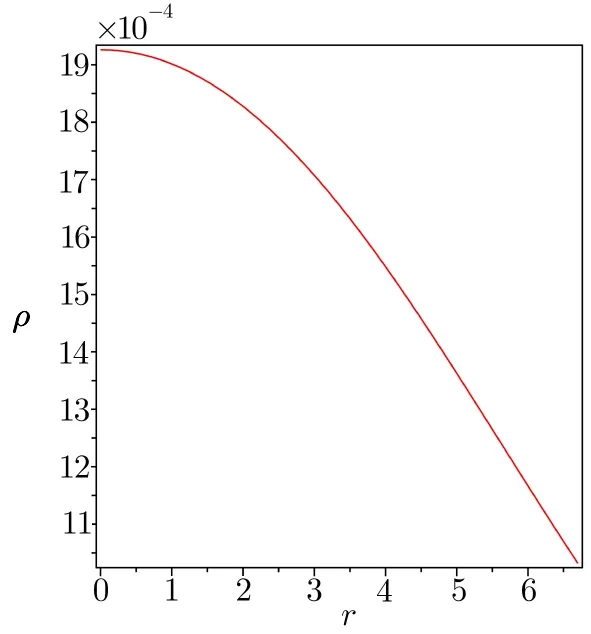
Fig.1 (Color online)Matter density is plotted against r inside the stellar interior by taking a=915,b=0.0042,α=0.25,β=0.000 258.
Plugging Eq.(13)into Eq.(12)we get,

where A1,A2,A3,and A4are constants which are given by,

Integrating Eq.(14)we get,


“D” is the constant of integration and will be obtained from the boundary conditions.
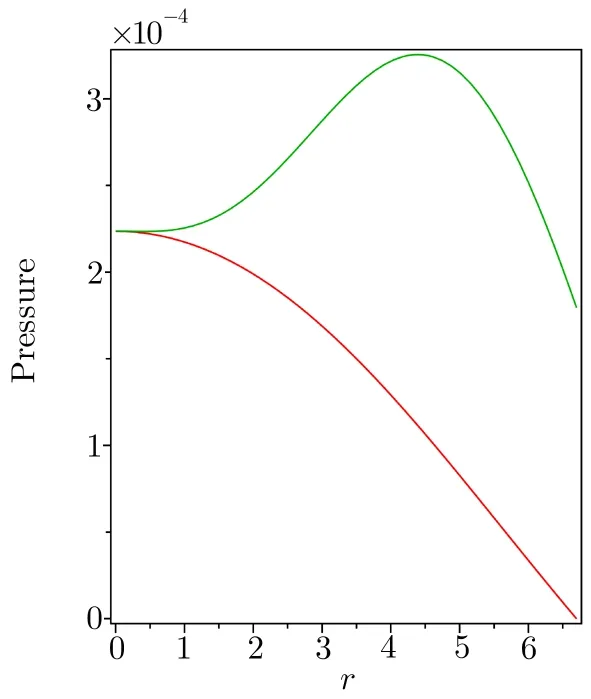
Fig.2 (Color online)Variation of radial and transverse pressure are plotted against r by taking the same values of the constant mentioned in Fig.1.Green color dashed line represents the transverse pressure and red color solid line represents the radial pressure.
The matter density,radial and transverse pressure are obtained as,

where 8π∆ is given by,

4 Boundary Condition
The interior spacetime for our proposed model continuously match to the Schwarzschild space time

outside the event horizon,i.e.,r>2M.
Using the continuity of eνand eλacross the boundary r=rΣ,

From Eqs.(15)and(21)we get,

5 Physical Analysis of the Present Model
The central density and central pressure is obtained by,

Differentiating Eqs.(1)–(3)with respect to x we get the following equations.

where,

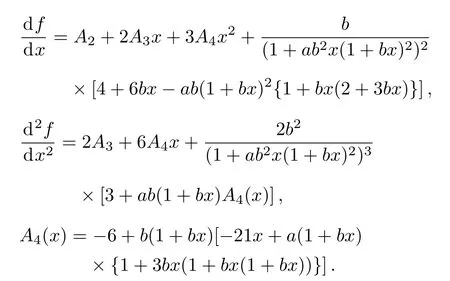
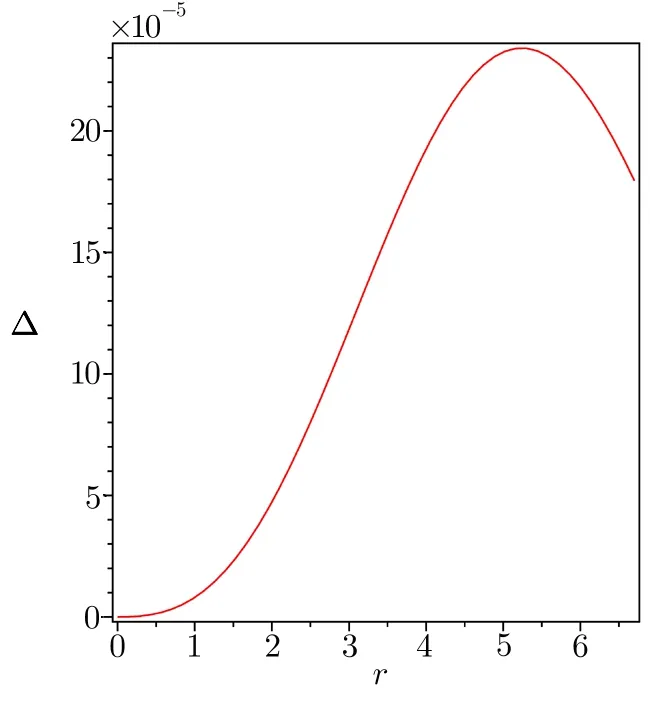
Fig.3 (Color online)Variation of anisotropic factor is plotted against r by taking the same values of the constant mentioned in Fig.1.
5.1 Energy Conditions
In this section we check the different energy conditions for our proposed model.We know that for a model of compact star the energy conditions viz,null energy condition(NEC),weak energy condition(WEC),strong energy condition(SEC)and dominant energy condition(DEC)is satisfied if the following inequalities hold simultaneously:

With the help of graphical representation in Fig.5,it has been found that all the energy conditions are satisfied by our model.
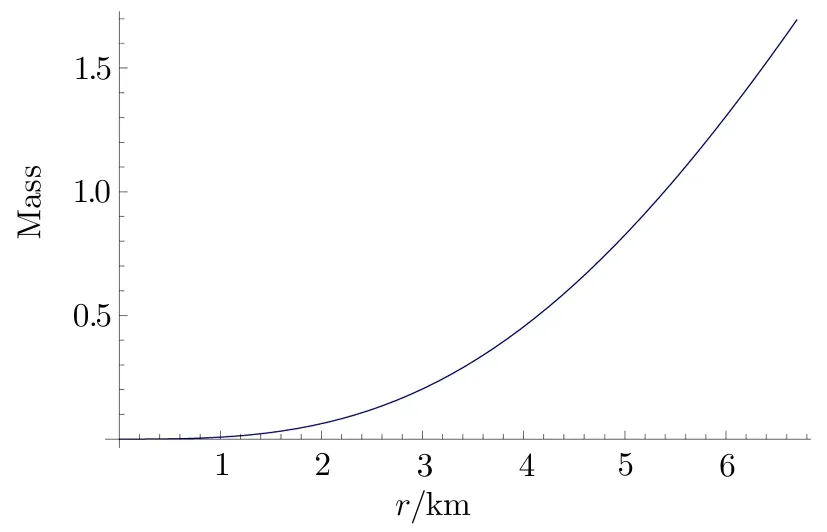
Fig.4 (Color online)Variation of mass function is plotted against r by taking the same values of the constant mentioned in Fig.1.
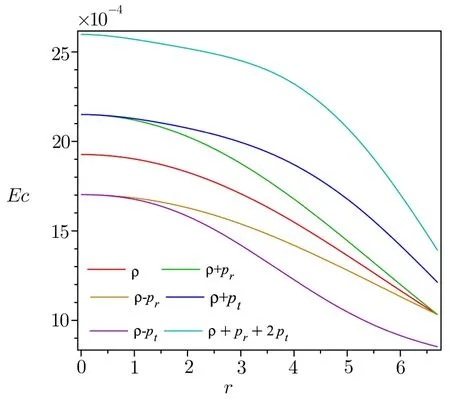
Fig.5 (Color online)The NEC,WEC,SEC and DEC are plotted against r for the compact star Her X-1 by taking the same values of the constant mentioned in Fig.1.
5.2 Mass Radius Relationship
The mass function for our model is obtained as,


The compactness factor(u(r))and surface redshift(zs(rΣ))is obtained as,

by using the relationship,
The pro file of mass function is plotted against r in Fig.4,which is monotonic increasing and regular inside the stellar interior.The pro file of the compactness factor is shown in Fig.6.

Fig.6 (Color online)Compactness factor is plotted against r by taking the same values of the constant mentioned in Fig.1.
5.3 Junction Conditions
In this article,the interior solution of a static,anisotropic compact star,governed by a linear equation of state pr= αρ − β with 0< α <1 and positive β,is matched with an exterior Schwarzschild vacuum solution with p= ρ =0 at a junction surface Σ,with junction radius r=R.The metric coefficients are continuous at the junction surface S where r=R,but their derivatives may not be continuous at the junction.We shall now utilize Darmois-Israel[26−27]formalism to determine the surface stresses at the junction interface.The intrinsic surface stress energy tensor Sijat the junction surface Σ is obtained from the Lanczos equation[28−31]in the following form

The discontinuity of the second fundamental form or extrinsic curvaturesacross the junction interface is given by,

where the second fundamental form is defined as,


with nνnν=1,where ξiis the intrinsic coordinate in S.The parametric equation for S is given by f(xα(ξi))=0.Here+and−corresponds to respectively exterior(Schwarzschild spacetime)and interior space time of the star.Using Lanczos equation[28−31]the surface energy density Σ and surface pressure P are obtained as


6 Stability
6.1 Stability under Three Forces
The generalized Tolman-Oppenheimer-Volkoff(TOV)equation for this system is described as

where MG(r)represents the gravitational mass within the radius r,which can derived from the Tolman-Whittaker formula and the Einstein’s field equations and is defined by

Plugging the value of MG(r)in Eq.(40)we get

Equation(42)can be written as,

where,
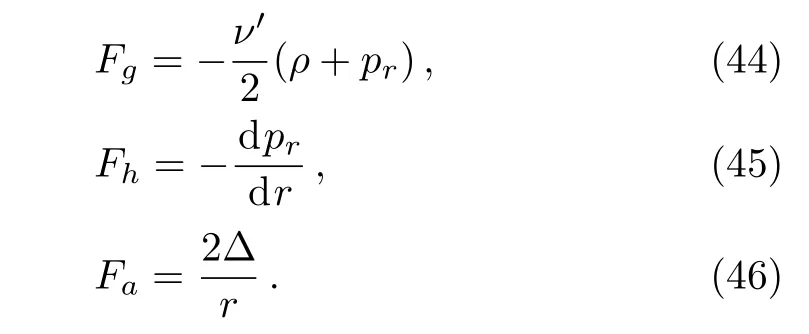
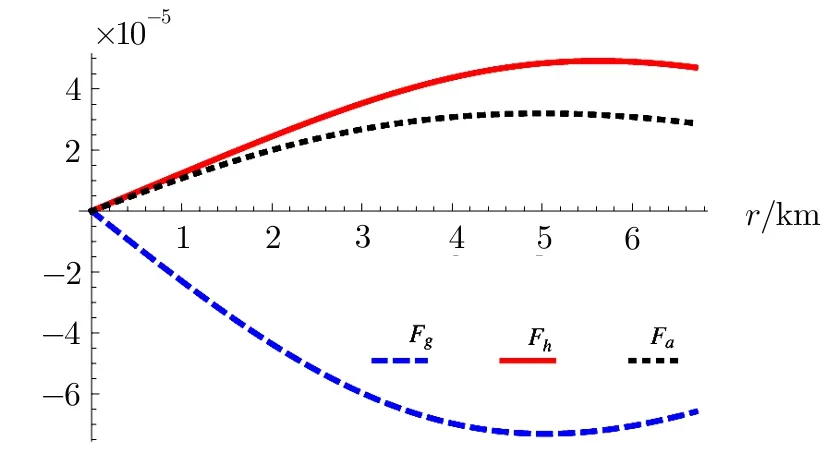
Fig.7 (Color online)Counterbalancing of three forces are plotted against r by taking the same values of the constant mentioned in Fig.1.
The pro files of the three different forces acting on the system are shown in Fig.7.The figure shows that gravitational force is negative and dominating in nature which is counterbalanced by the combine effect of hydrostatics and anisotropic forces to keep the system in equilibrium.
6.2 Adiabatic Index
The adiabatic index Γ,provides the stability of a stellar configuration is given by,

Now Γ>4/3 is the condition for the stability of a Newtonian sphere and Γ=4/3 being the condition for a neutral equilibrium proposed by Ref.[32].This condition changes for a relativistic isotropic sphere due to the regenerative effect of pressure,which renders the sphere more unstable.For an anisotropic general relativistic sphere the situation becomes more complicated,because the stability will depend on the type of anisotropy.For an anisotropic relativistic sphere the stability condition is given by[33]

where pr0,pt0,and ρ0are the initial radial,tangential,and energy density in static equilibrium satisfying Eq.(42).The pro file of the adiabatic index Γ is shown in Fig.8.
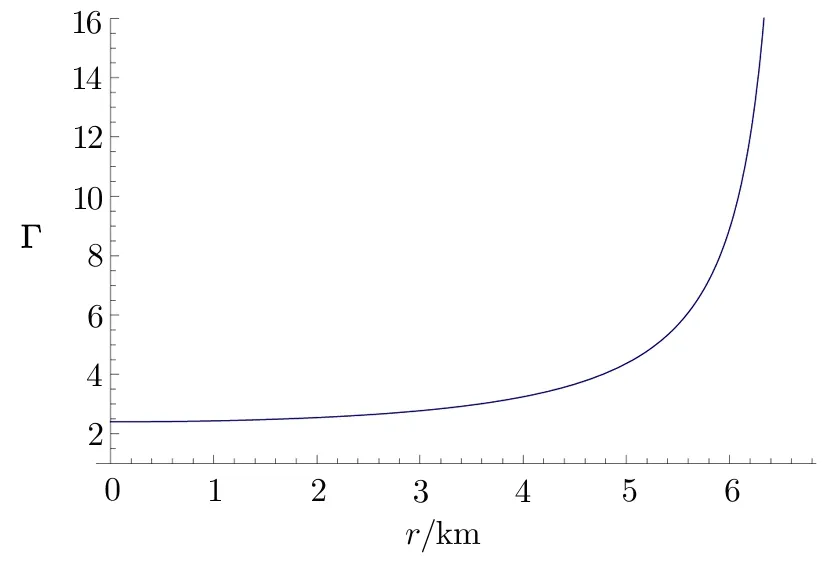
Fig.8 (Color online)Variation of adiabatic index Γ is plotted against r by taking the same values of the constant mentioned in Fig.1.
6.3 Causality Condition
For a physically acceptable model the radial and transverse velocity of sound should lie in the rangewhere radialand transverse velocityof sound is defined as,

The expression for dpt/dx,dρ/dx are obtained in Eqs.(25)and(23)respectively.Due to the complexity of the expression we have taken the help of graphical representation.The pro file ofare shown in Fig.9.Figure shows that our model satisfies the causality condition.According to Ref.[34]the region of the anisotropic fluid sphere whereis potentially stable but the region whereis potentially unstable.For our model it is true that(Fig.9)and hence model is potentially stable.Since,Figure 10 shows that our model satisfies the condition of Ref.[36]i.e.,

Fig.9 (Color online)Subliminal velocity of sound is plotted against r by taking the same values of the constant mentioned in Fig.1.Blue color dashed line for radial velocity of sound and red color solid line for transverse velocity of sound.
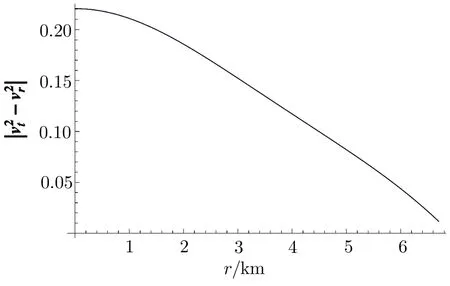
Fig.10 (Color online)is plotted against r by taking the same values of the constant mentioned in Fig.1.
7 Discussion and Conclusion
In the present study of mathematical model of relativistic anisotropic compact stellar model provides some interesting and physically acceptable solutions of the different metric potentials and the other physical parameters like density,pressure,mass etc.of the system.
(i)From Eqs.(16),(17)and(18)we can observe that all the solutions are non singular at the centre(i.e.,r=0).
(ii)We have obtained the value of the constant D using matching condition.
(iii)From the graphical representation,it is found that the matter density,radial pressure(pr)and transverse pressure(pt)are all positive and monotonic decreasing function of r.
(iv)Taking a=915,b=0.0042,α=0.25,β=0.000 258 and using the conditions pr(r=rΣ)=0,we obtain the radius of the star 6.7 km and mass of the star is obtained as,which is very close to the observational data of compact star Her X-1(Mass=.[35]
(v)Plugging G and c in the expression of ρ and prwe obtained the central density and central pressure as 2.6×1015gm/cc.2.72×1035dyne/cm2,1.39×1015gm/cc.,which indicates the physical stability of our model.
(vi)From graphical representation,it is found that the anisotropic factor∆>0,i.e.,anisotropic force is repulsive in nature,which implies that more compact object to be formed as discussed by Ref.[7].Moreover it vanishes at the center of the star.
(vii)With the help of graphical representation,all energy conditions are satisfied by our proposed model.
(viii)By using the value of parameters we have obtained compactness factor=0.253 and surface redshift zs=0.423.
(ix)Figure 7 shows three forces acting on our model are counterbalancing to keep the system in static equilibrium and condition[36]is well satisfied.
(x)The adiabatic index Γ>4/3 and the causality conditions are satisfied by our model,which ensures that our model is potentially stable.
Finally,we can say that all these results that we have obtained for our present investigation of compact stars are theoretically as well as physically admissible.So we can conclude that this model can be used for the description of ultra compact stars in future.
Acknowledgments
I acknowledge Dr.Farook Rahaman and Dr.Piyali Bhar for helpful and valuable discussion.I am thankful to anonymous referee for his/her valuable comments,which helps to improve the manuscript.
杂志排行
Communications in Theoretical Physics的其它文章
- Optical Solitons and Stability Analysis in Ring-Cavity Fiber System with Carbon Nanotube as Saturable Absorber
- Scheme for Asymmetric and Deterministic Controlled Bidirectional Joint Remote State Preparation∗
- Lump and Stripe Soliton Solutions to the Generalized Nizhnik-Novikov-Veselov Equation∗
- A Practical E-Payment Protocol Based on Quantum Multi-Proxy Blind Signature∗
- Convective Heat and Mass Transfer in Magneto Jeffrey Fluid Flow on a Rotating Cone with Heat Source and Chemical Reaction
- Scattering and Bound States of the Dirac Particle for q-Parameter Hyperbolic Pöschl-Teller Potential
